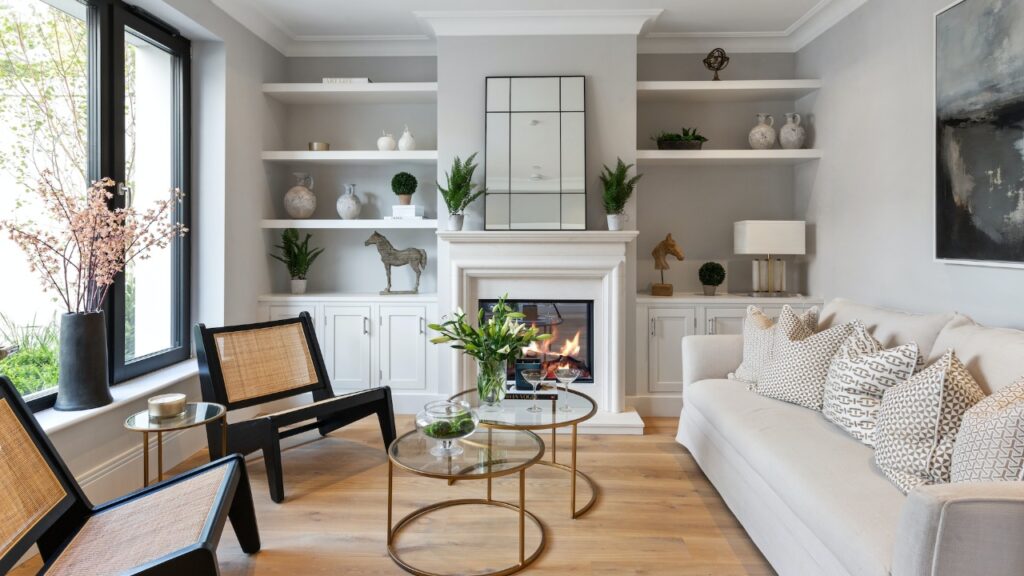Rugs can be a wonderful addition to a living room, adding style, comfort, and warmth to the space. However, there are situations where it might be best not to use a rug or where you should carefully consider your options. In this guide, we’ll explore scenarios and reasons when not to use a rug in the living room.
1. Small Living Rooms
- Why Not to Use a Rug: In small living rooms, every square foot of space counts. Placing a rug in a compact living room can make the room feel even smaller. If you have limited space, it might be better to leave the floor uncovered to create a more open and spacious feel.
2. Minimalist Design
- Why Not to Use a Rug: If you’re aiming for a minimalist or ultra-modern design in your living room, rugs might not be the best choice. Minimalist designs often favor clean lines and uncluttered spaces. A rug, especially a large or colorful one, can contradict this aesthetic.
3. High-Maintenance Preferences
- Why Not to Use a Rug: Rugs require regular maintenance, including vacuuming, spot cleaning, and sometimes professional cleaning. If you prefer a low-maintenance living room, skipping the rug can save you time and effort.
4. Allergies
- Why Not to Use a Rug: Rugs can trap allergens like dust mites, pet dander, and pollen. If you or a family member has allergies, it might be best to avoid rugs in the living room to reduce allergen buildup.
5. Heat and Humidity
- Why Not to Use a Rug: In areas with high heat and humidity, rugs can trap moisture and become a breeding ground for mold and mildew. For rooms exposed to extreme heat or humidity, it’s better to forgo rugs or choose moisture-resistant materials like outdoor rugs.
6. High Traffic Areas
- Why Not to Use a Rug: In living rooms with heavy foot traffic, rugs can wear out quickly, leading to visible signs of wear and tear. If you expect a lot of activity in your living room, especially with children and pets, you may prefer to keep the floor bare or choose a more durable flooring option.
7. Unstable Flooring
- Why Not to Use a Rug: If your living room has unstable or uneven flooring, like loose floorboards or tiles, a rug might not sit properly and can be a tripping hazard. It’s essential to address the flooring issues before considering a rug.
8. Frequent Furniture Rearrangement
- Why Not to Use a Rug: If you enjoy frequently rearranging your furniture or experimenting with different layouts, a rug can be cumbersome. Moving heavy furniture over a rug can cause it to shift and become misaligned. In such cases, a rug might not be practical.
9. Concrete or Stone Flooring
- Why Not to Use a Rug: Some living rooms have concrete or stone flooring, which can feel cold and uncomfortable. While rugs are a typical solution for adding warmth, some people prefer the natural coolness of these materials. In such cases, a rug might not be necessary.
10. Intentional Open Concept Design
- Why Not to Use a Rug: In open concept living spaces where the living room flows seamlessly into the dining area or kitchen, you might opt to go without a rug to maintain a continuous, cohesive look. Rugs can visually segment spaces, and an open concept design aims to eliminate these divisions.
11. High-End Flooring Materials
- Why Not to Use a Rug: If your living room features high-end and visually appealing flooring materials like natural hardwood, marble, or luxurious tiles, you may want to showcase and enjoy these materials without covering them with a rug.
12. Pets
- Why Not to Use a Rug: While some pet owners love the idea of a cozy rug, others find it challenging to keep clean, especially if their pets shed a lot or are prone to accidents. Rugs can trap pet hair and odors, and cleaning can be a hassle. In such cases, you might consider alternatives like pet-friendly flooring.
13. Safety Concerns
- Why Not to Use a Rug: For households with members who have mobility issues, such as elderly individuals or young children just learning to walk, rugs can pose a tripping hazard. It’s essential to prioritize safety and consider floor coverings carefully.
14. Budget Constraints
- Why Not to Use a Rug: Quality rugs can be a significant investment. If your budget is limited, or you’d rather allocate your funds to other aspects of your living room, you can opt to go without a rug. There are various ways to decorate a living room without one.
15. Vibrant Wall-to-Wall Carpet
- Why Not to Use a Rug: If your living room already features wall-to-wall carpeting that you find visually appealing and comfortable, you might not need an additional area rug. Using two different types of carpet can create a clashing effect.
16. Unique Flooring Patterns or Designs
- Why Not to Use a Rug: Some living rooms have unique, eye-catching flooring patterns or designs that serve as the room’s focal point. In such cases, adding a rug might detract from the beauty and appeal of the existing flooring.
Conclusion
While rugs can enhance the style and comfort of a living room, there are valid reasons and situations where it might be best not to use a rug. Your design preferences, lifestyle, maintenance considerations, and room-specific factors should guide your decision. Ultimately, the choice of whether or not to use a rug in your living room should align with your individual needs and preferences.


